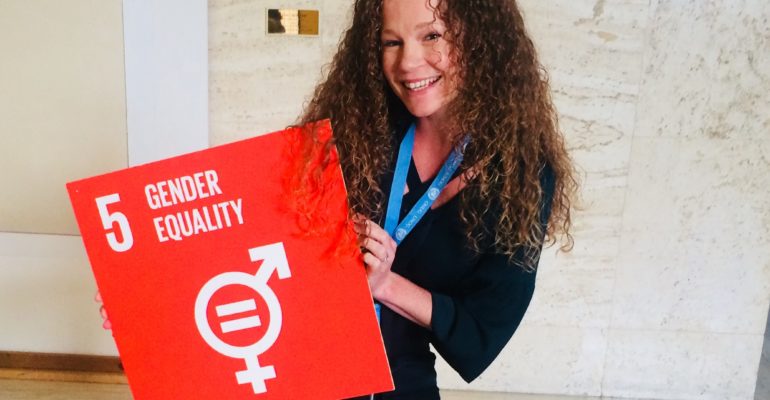The Interlinkages Between Gender Equality (SDG 5) and Sustainable Cities and Communities (SDG 11), Part 1 of 4
by SI UN Representative, Angela Sauvage
One of the most powerful elements about the Sustainable Development Goals (SDGs) is their interconnectedness. Simply put, we cannot achieve one Goal without achieving the others. Actors within the private, public, and NGO sectors agree that in order to leave no one behind, we must work to achieve each Goal and target by 2030.
To support these conversations and enable actions among the Goals, the SDG Lab has developed their ‘So What’ Series. The ‘So What’ Series is an interactive dialogue that explores the intersectorality of the 2030 Agenda by exploring the linkages between two seemingly unrelated SDGs. These events aim to promote an integrated, horizontal approach to SDG action.
For example, a past ‘So What’ discussion explored the interlinkages between Gender Equality (SDG 5) and Sustainable Cities and Communities (SDG 11). The aim of the discussion was to show how linking these goals can accelerate results.
I must give the SDG applause, because they did an excellent job of showcasing panelists from a range of sectors and experiences. From technology to law enforcement and media to city governance, I’m confident you’ll find at least one key takeaway you could consider for your community.
So without further delay, let’s begin Part 1 of this 4 part series.
The City of Geneva: Transitioning from Written Statements to Impactful Actions
 Ms. Héloïse Roman, Project Manager for Gender Equality for the City of Geneva’s Agenda 21 – Sustainable City, spoke openly about the Geneva’s efforts to make equality between women and men a political priority. She stated that:
Ms. Héloïse Roman, Project Manager for Gender Equality for the City of Geneva’s Agenda 21 – Sustainable City, spoke openly about the Geneva’s efforts to make equality between women and men a political priority. She stated that:
Local public authorities have an important role to play in promoting equality between women and men, one of the foundations of a true democracy.
As such, the City of Geneva is implementing both internal and external measures to combat gender stereotypes and the reproduction of inequalities.
I found the discussion to be a great example for how we Soroptimists can work with and encourage our local government to apply a ‘gender lens’ throughout all levels of city and community policy, planning, and development.
For example, the City of Geneva focuses on these three areas of implementation:
- After gathering internal and external data, the City of Geneva made a commitment to focus directly on the key issues facing women in the City and report on their progress. The approach to addressing the issues may have varied, for example they might have used wide-spread campaigns, worked with partners on training, or collaborated with municipal groups on promoting gender equality, but the City was aligned on the main issues women were facing and they were committed to tracking their results.
- Next, the City of Geneva took a deep dive to review all of the City’s policies to insure they were not reproducing discrimination on a daily basis. It’s important to note that Ms. Roman admitted that this is continually a work in progress, but they are making positive steps to assure that new building projects, programs for sports, the design of public spaces, and many other daily affairs are addressed from a gender perspective.
- Lastly, the City of Geneva works internally to make sure they ‘walk the walk’ and can be the example for other organizations and governments. In doing so, they’re continuing to monitor, review, and make updates where needed to eliminate any discriminations within their own government.
When asked about unexpected outcomes of their efforts, Ms. Roman stated that even if this was started as a long-term vision, they are already seeing changes only a few years in. Additionally, they’re seeing other governmental sectors take note of their work and start to implement similar programs.
“Integration doesn’t just happen” she stated, and in addition, her team members often act as advisors and advocates, promoting gender equality measures and best practices throughout all the local policy levels.
Now thinking about your own local government:
- What steps is your local government taking to ensure gender equality throughout their programs, policies, and practices?
- How might you and your Soroptimist club get involved to support their efforts and insure real progress is being made?
- What other local governments have you seen take steps towards a gender inclusive environment? What has made them successful? Or not successful?

Engage with us!
You can comment below so please do share your responses below – your feedback will help us to better tailor future blog discussions and programmes to your interests”.


Super blog Angela thank you for writing for us and we look forward to Part 2!
Angela, thank you for highlighting this SDG lab. It is important for members to work on the issues facing women and girls in their own communities.. We need to work together to advance the 2030 Agenda. Bev Bucur, SI Director of Advocacy.
I read your e mail with real interest, particularly how Soroptimist clubs could start to raise awareness of the need for gender equality in all aspects of life within their own towns and cities. Some points to start discussion would be useful. I look forward to your next blog.